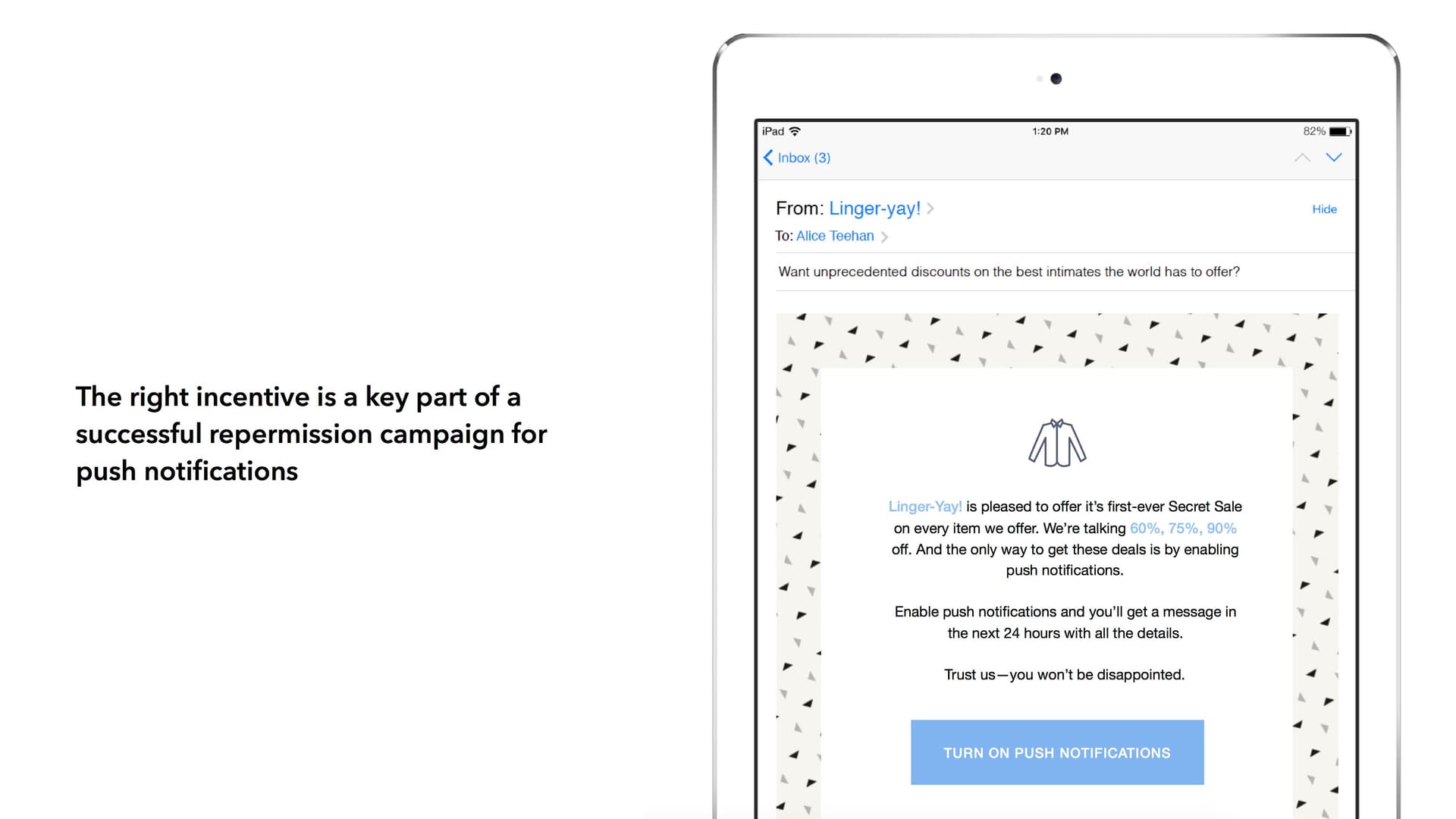Don’t Give Up On Push: 6 Steps to an Effective Re-Permission Campaign
Published on January 28, 2016/Last edited on January 28, 2016/7 min read


Todd Grennan
Content Production Principal, Content Marketing at BrazeDear reader: This blog post is vintage Appboy. We invite you to enjoy the wisdom of our former selves—and then for more information, check out our new Cross-Channel Engagement Difference Report.
A lot of people opt out of push notifications—nearly half of all mobile users, by some measures. Some do it because they’re not convinced of the value in receiving push from the apps they use; others because they’ve been overwhelmed by a barrage of repetitive messages. But whatever their reasons, when a customer opts out of push, it has a big impact, making it impossible for brands to reach them using this powerful channel.
Not every customer is best engaged with push notifications, so marketers shouldn’t make the mistake of becoming reliant on push to reach their mobile audience; plus, multi-channel campaigns tend to be even more effective than push notifications alone. But push notifications are a powerful outreach tool and an important part of a marketer’s mobile outreach mix. That means it’s important to do what you can to convince your audience to opt in. The best way to do that is to use in-app messages to walk customers through the benefits of agreeing to receive push and making sure that the messages you send through this channel are relevant and valuable to the customers receiving them. But what about the people who opted out of push notifications because of bad experiences with other apps?
Well, they might be a good audience for a push re-permission campaign.
What’s a push re-permission campaign?
In order to track personal data, access elements of devices running your brand’s app, or—in this case—to send certain kinds of messages, you need to ask your customers for permission. On Android devices, these permissions are displayed en masse before customers download your app; on iOS, permissions are requested as needed by your app.
A push re-permission campaign, then, is messaging outreach that your brand sends to a customer who has declined (or rescinded) permission to send push notifications in order to convince them to change their mind.
When does it makes sense to send a push re-permission campaign?
When you have engaged customers who aren’t getting the full value that your brand can provide because they’ve opted out of push.
Okay, but how do you create an effective push re-permission campaign?
1. Find your target audience
To start, you have to identify which members of your audience have opted out of receiving push notifications. For many brands, that means using a mobile marketing automation platform to create an audience segment of current customers who don’t have push enabled and then refining from there.
While it’s possible to send a push re-permission campaign to every customer who has opted out, that’s not necessarily the best approach. If you have customers who haven’t enabled push but who are also lapsing or inactive, it makes more sense to focus on convincing them to re-engage with your brand, rather than sending them messages designed to get them to turn on push notifications. Choose your battles.
2. Pick a messaging channel (or channels)
If a customer has opted out of receiving push notifications, that makes it impossible to use that channel to convince them to change their mind. That means that only brands with a multi-channel approach to their customer messaging will be able to create effective push re-permission campaigns.
If your brand uses a mobile marketing platform that supports in-app messages or News Feed Cards, consider using them first. These messaging channels don’t require permissions in order to work and can reach any customer who visits your app, making them a good way to get your message to engaged members of your audience. Email can also be effective at reaching customers who have opted out of push, but it’s important to be thoughtful about how you use this channel: sending too many emails that customers don’t engage with can imperil your delivery reputation, harming your ability to email even deeply engaged customers.
3. Choose a compelling incentive
When you send a customer a push re-permission campaign, you’re asking them to change their mind. Convincing someone to do that is never easy, especially when they may have had bad experiences with the push notifications they received in the past. To get them to engage with your request, having an incentive that speaks to your audience is essential.

What should that incentive be? Well, the right choice is going to vary for different verticals and different brands. If your app has a retail focus or offers in-app purchases, that incentive might be a significant discount. On the other hand, an app focused on social networking could use early access to new stickers or messaging options to persuade customers to opt in for push.
The key is to identify why customers chose to use your app in the first place and then offer them something that will make that experience even more appealing. Ideally, the incentive should do two things: increase the chances that the recipient agrees to opt in for push notifications AND demonstrate the kind of value that receiving push notifications from you could provide in the future.
4. Find a pitch that resonates (and make it personal)
Just as understanding your audience is essential to identifying an incentive that will actually incentivize the behavior you want, the messages you send as part of your push re-permission campaign need to fit both your brand and the audience you’re looking to convince.
To do that, take advantage of the data you’ve collected on the customers you’re targeting and use it to personalize your outreach. By including these customers’ names and other relevant information in your message, you can increase engagement and give your campaign a better chance to succeed.
5. Test, test, test
A push re-permission campaign isn’t the kind of thing you should send someone 50 times. That would be counterproductive and a good way to convince the recipient to uninstall your app and badmouth you on Apple’s App Store or Google Play. Given that, if you’re going to send someone a push re-permission campaign, you need to make it count.
One good way to do that is to take advantage of multivariate testing to optimize the messages you send. Try out different message variants with different copy, different images—even different incentives, if you identified multiple options that seem appealing. Then use your findings to adjust the campaign that’s sent to the bulk of your target audience.
6. Assess the results
Once you’ve sent your first push re-permission campaign, take a careful look at your campaign results. After all, while it’s possible to reduce the number of people opting out of push by asking for permissions in an effective manner and using the channel thoughtfully, you’re always going to have some people who choose not to enable push notifications. And the results of this first campaign can be a good indicator of whether it’s worthwhile to use re-permissioning outreach in the future.
Look at the numbers. Did customers who received the push re-permission campaign opt in for push? Or did sending the campaign increase your app uninstalls? (Likely both of those things happened, so take a hard look at the cost of those uninstalls, the benefit of the push opt-ins, and what they mean for your brand). Mobile marketing depends on testing, iteration, and analytics, and knowing how actual customers responded to your re-permissioning outreach makes it easier to determine whether there’s value in this kind of campaign for your brand, and—if so—how to adjust your push re-permissioning messaging going forward.
Anything else?
Push re-permission campaigns aren’t a cure-all. It’s always better to find ways to keep customers from opting out of push in the first place instead of spending time and energy to convince them to change their minds. But if you have a significant number of engaged users who have opted out of push, a push re-permission campaign is worth trying.
For more on re-permission campaigns of all kinds, check out our re-permissioning overview blog post.
Related Tags
Be Absolutely Engaging.™
Sign up for regular updates from Braze.




